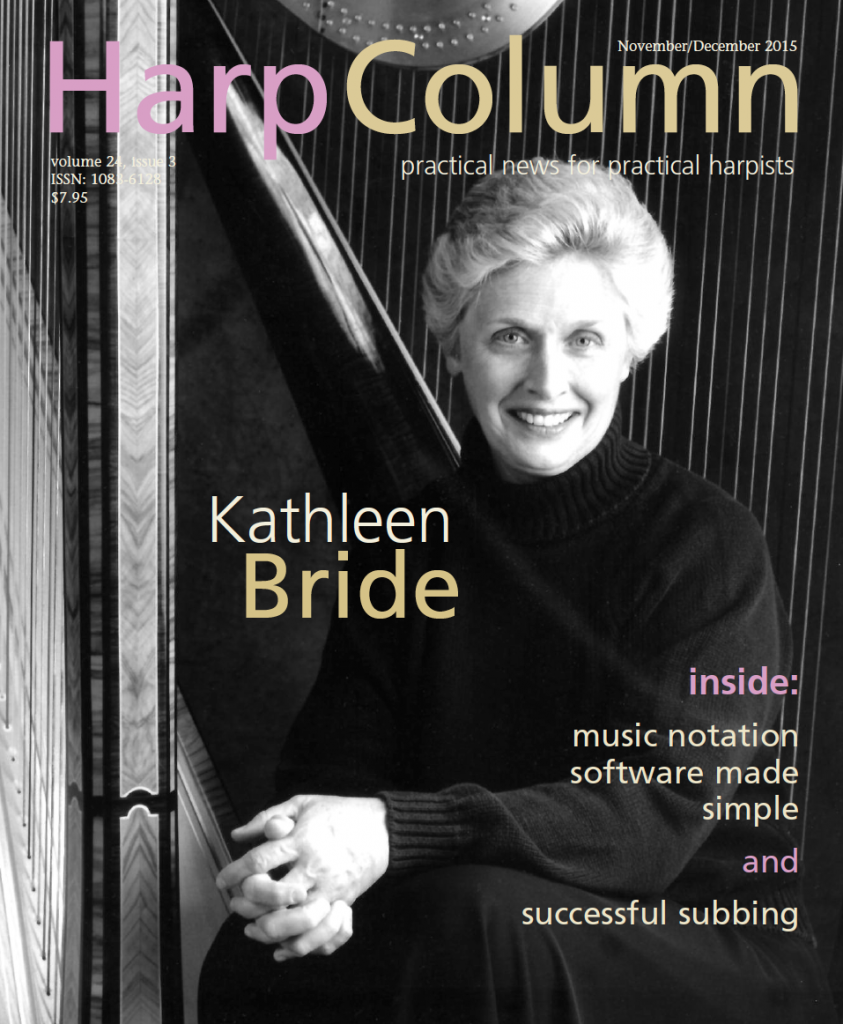
In the November/December 2012 issue, we looked at some marvelous seasonal arrangements with a jazzy flair by Christa Grix. She has added two pieces for harp and violin (or flute) to four of her earlier Christmas solos and compiled them into a book. All is Calm includes “A Child is Born,” “Silent Night Reflections,” “Moonlight on Snow,” and “In the Bleak Midwinter” for solo pedal harp, and “Suo Gan” and “Midwinter Night’s Dream” for harp and violin. There is a separate, pull-out violin part and the violin is also included on the harp part.
“Suo Gan” is a traditional Welsh Lullaby and it is a poignant and moving melody. The harp has a short intro as well as a brief interlude at the top of the third page. There are several pedal changes, but none are difficult and they are all clearly marked below the staff.
“Midwinter Night’s Dream” is an original composition by Ms. Grix. It starts out with sort of a fingered gliss and contains some pedal slides, muffled chords, scales in harmony with the violin, and a few harmonics at the end. There are some frequent pedal changes, but most are included. The A-natural pedal was omitted in measure 39 and there is a stray E-natural floating near the violin part in measure 52. The typesetting on this piece is a little crowded, making it a little difficult to read in some spots. Perhaps if the violin part were reduced, it would be possible to fit one more system on each page and the measures wouldn’t be as congested. It is a stimulating piece regardless of these minor issues.
If you haven’t already added Ms. Grix’s other arrangements to your repertoire, now that you can find them all in one book you have even more incentive!

The holidays provide an opportunity for beginners to play some well-known music that isn’t too difficult. To that end, Joy Slavens has published two books of easy Christmas carols for harp. Joy at Christmas (Book 1) has eight traditional carols for beginners. Each piece has a short intro.
“O Come, O Come, Emmanuel” is mostly one hand at a time. “Still, Still, Still” and “O Christmas Tree” share the melody between both hands at some point. “What Child Is This” and “Deck the Halls” have some short scale glisses. “God Rest Ye Merry, Gentlemen” requires some hand over hand playing. “Away in a Manger” and “Silent Night” use simple harmonies but thankfully avoid clunky triads as left hand accompaniment.
Book 2 has eight more carols intended for the late beginner. These are slightly more challenging than the first volume.
Several pieces including “The First Noel” and “Jingle Bells” have sections that are played an octave higher than written. “Jolly Old St. Nicholas/Up on the Housetop” has a simple segue that connects the two melodies. “Joy to the World” and a few others have scale glisses. The second verse of “O Come, Little Children” develops a little more with thirds in the right hand and fifths in the left hand. “I Saw Three Ships” and “Here We Come A-Wassailing” are simple yet pleasant arrangements. “In the Bleak Midwinter” is probably the most challenging selection with larger, rolled chords, a short arpeggio, and a busier accompaniment.
These collections provide beginners with satisfying renditions of short, familiar tunes and introduce them to simple embellishments. Both volumes can be played on lever harps tuned to at least F major and there’s still time to learn a few of these before Christmas!

If you need something for harp duet or ensemble, Meredith Mancini has published an ancient French carol, “Noël de Cluny” for lever or pedal harps. The music includes the score and separate parts for harps one and two.
This is a mournful, haunting melody in D minor. There are a few C levers that have to be preset and later moved in each part, but they are indicated with diamond-shaped notes and there is sufficient time to move them. No pedal changes are marked. No fingering is provided, but this music is not difficult. Each part carries the melody at some point and for part two, it is in the bass clef. The piece is just two pages long, and while it is short, it would add an interesting dimension to a duo or ensemble program.
Finally, although it is not new, if you need more for two harps (or ensemble), don’t overlook “Three European Carols” for two harps. Published by Lyon & Healy, these lovely arrangements by Ken Gist are entirely diatonic, so they are suitable for pedal or lever harp. A score and both parts are included and the typesetting is beautifully done.

The parts are evenly matched and each player gets a turn to play the melody on each piece. There is a music box quality to “Still, Still, Still” and it has one, well-planned page turn. It is in B-flat. “As Lately We Watched” is simple and pretty and sight-readable for an intermediate player. Both parts play harmonics in harmony at the beginning of “O Come, Little Children.” There are three verses to this sweet tune and Mr. Gist makes each one appealing.
Ken Gist is one of our finest arrangers. Since it has been a few years since this collection was published, it seems we are overdue for some new arrangements from him!
Happy Holidays! •







